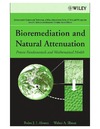A groundbreaking text and professional resource on natural attenuation technology Natural attenuation is rapidly becoming a widely used approach to manage groundwater and soil contamination by hazardous substances in petroleum-product releases and leachate from hazardous waste sites and landfills. This book provides, under one cover, the current methodologies needed by groundwater scientists and engineers in their efforts to evaluate subsurface contamination problems, to estimate risk to human health and ecosystems through mathematical models, and to design and formulate appropriate remediation strategies.
Incorporating the authors' extensive backgrounds as educators, researchers, and consultants in environmental biotechnology and hydrogeology, the text emphasizes new concepts and recent advances in the science, including:
- Quantification of the role of microbes in natural attenuation
- Biodegradation and chemical transformation principles
- Immobilization and phase change
- Biotransformation mechanisms
- Groundwater flow and contaminant transport
- Analytical models for contaminant transport and reaction processes
- Numerical modeling of contaminant transport, transformation, and degradation
Detailed descriptions of fundamental processes, characterization approaches, and analytical and numerical methods tied to relevant real-world applications make Bioremediation and Natural Attenuation: Process Fundamentals and Mathematical Models both a timely course text in hydrogeology and environmental engineering and a valuable reference for anyone in the groundwater or risk assessment professions.
 |
|
О проекте
|
|
О проекте


